Lingshui Cun Historic Village is located roughly 45
miles (75 km) from downtown Bĕijīng in the Méntóugōu
District (门头沟区) of Bĕijīng Province. Dr. Huang Wen Hui - China
University of Geoscience's excellent carbonate sedimentary geochemist -
and three of his students took us on a trip to visit
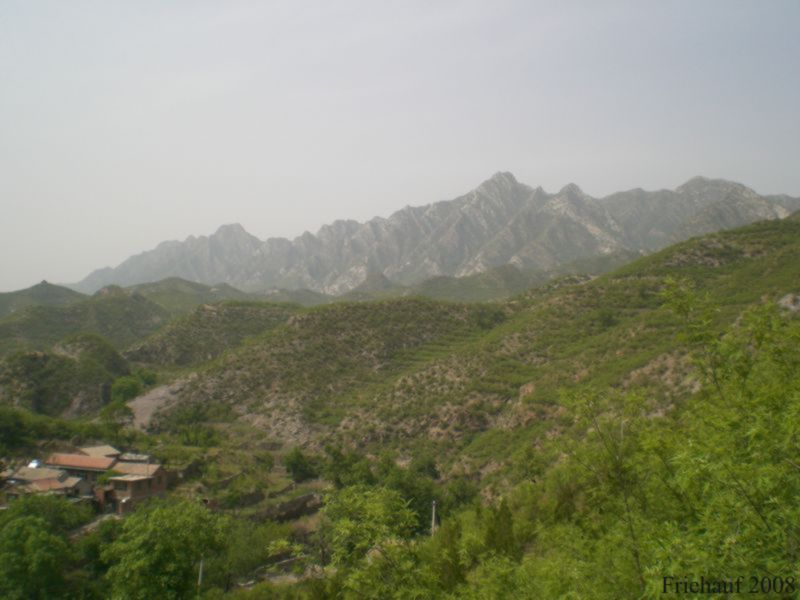
Countryside around Lingshui Cun

Countryside around Lingshui Cun

Countryside around Lingshui Cun
O
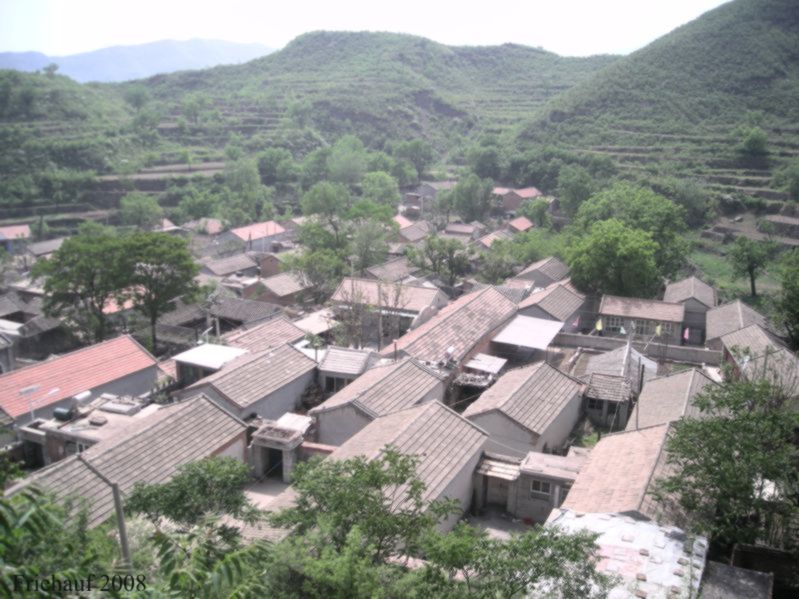
verlooking Lingshui Cun

Many of the doors in Lingshui Cun were decorated with
colorful signs. Every door was different and personal.

An old fellow with a basketful of sticks

Typical view in the village

Old well in Lingshui Cun village. The stonework in
the walls was done in this herringbone pattern throughout the
village.

Dr. Huang demonstrates the use of a grain mill.

We each tried our hand with the mill. It was
remarkably easy to turn and spun in such a way as to "smear" grains
between the stones rather than just "squashing" them. Simple
technologies can be surprisingly efficient!

The fields tended by the farmers who live in the village

The benefits of electrification as represented on a
tiled mural on one of the town walls.

A beautiful mural with a message beyond my ability to
read in Chinese.

We had lunch with one of the farmers and his wife.
The food was delicious!

Close-up of part of lunch

A nice, typical home in Lingshui Cun historic village
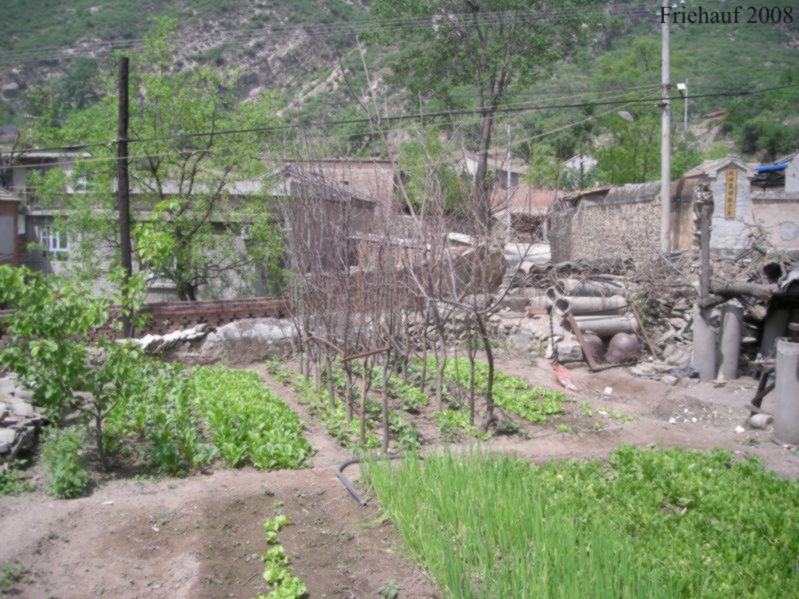
The farmer's family had a small garden that they tended
behind their house.
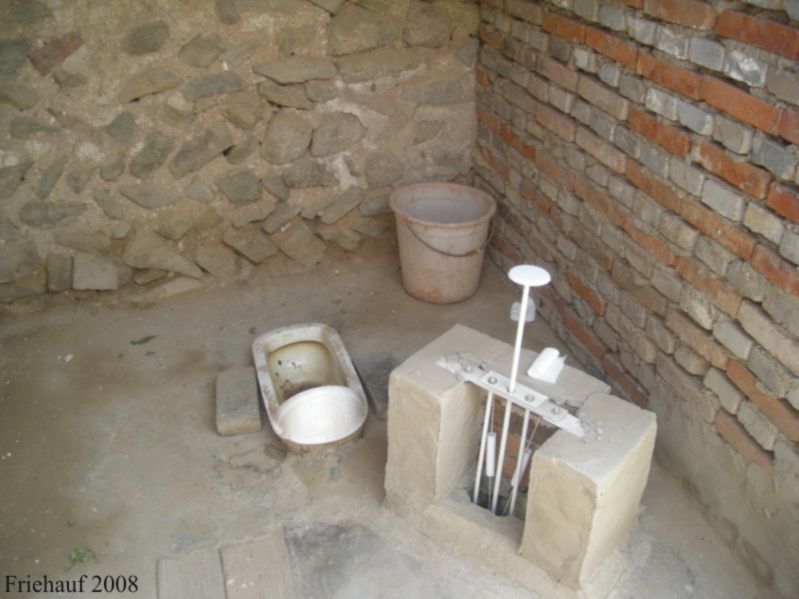
The farmer's outhouse toilet was a nice little setup
with a pump-driven flush system. It was great during the summer,
but I imagine things could get pretty cold in winter!
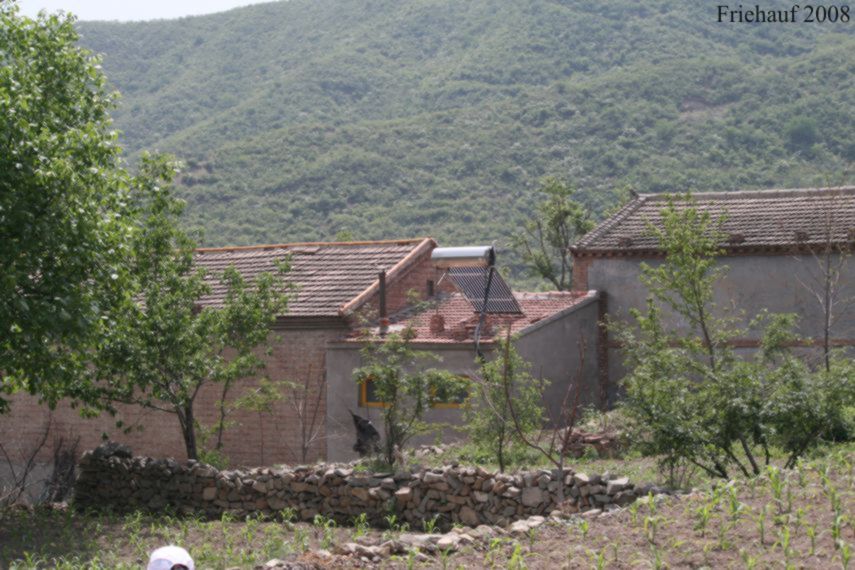
The Chinese are good about using the resources available
for simple things. This house, for example, has a solar water
heater. No coal or oil gets burned and the mechanism is simple
(easy to maintain).

The heater in the house and the stove burned coal
brickettes. These were made by grinding low-grade coal into a
power, separating the coal from the culm (non-burning rock with which
the coal occurs), and then pressing the coal powder into brickettes of
a standard shape and size. The holes in the brickette allow more
oxygen to get to the fire.

Some houses in the next village down the line use raw
coal blocks that are delivered by truck. The streets were very
rough, though, so some of the coal fell off the truck. Anthony -
always a thoughtful guy - gladly helped re-load some.

We arrived in China on the day of the big
Sìchuān
earthquake of May 12, 2008. (
click
here for pdf version). The Chinese people really came
together well for this. People from ALL walks of life - rich,
poor, young, old, etc. - all contributed to helping the victims of the
quake.

This was posted on the wall by the entrance to the
village. It summarizes each person's donations to the earthquake
relief effort.
I was really impressed by how so many people pitched in. Lu
Beibei - the graduate student at CUG-B who taught us tai chi -
text-messaged her donation using her cell phone while we were on a
bus. Lu Beibei is by NO means a wealthy person - graduate
students live hand-to-mouth everywhere in the world - but she still
wanted to help out. Lu Beibei was an extraordinary young woman in
many respects, living a meaningful and thoughtful life. I have a
lot of respect for her.

Rock strata in the mountains were upturned to a vertical
dip - evidence of a violent uplift in the region's geologic past.
 Hénán molybdenum
project -
Lingshui Cun Historic Village
tourism photos
Hénán molybdenum
project -
Lingshui Cun Historic Village
tourism photos Hénán molybdenum
project -
Lingshui Cun Historic Village
tourism photos
Hénán molybdenum
project -
Lingshui Cun Historic Village
tourism photos Lingshui Cun Historic Village is located roughly 45
miles (75 km) from downtown Bĕijīng in the Méntóugōu
District (门头沟区) of Bĕijīng Province. Dr. Huang Wen Hui - China
University of Geoscience's excellent carbonate sedimentary geochemist -
and three of his students took us on a trip to visit
Lingshui Cun Historic Village is located roughly 45
miles (75 km) from downtown Bĕijīng in the Méntóugōu
District (门头沟区) of Bĕijīng Province. Dr. Huang Wen Hui - China
University of Geoscience's excellent carbonate sedimentary geochemist -
and three of his students took us on a trip to visit  Countryside around Lingshui Cun
Countryside around Lingshui Cun Countryside around Lingshui Cun
Countryside around Lingshui Cun Countryside around Lingshui Cun
Countryside around Lingshui Cun verlooking Lingshui Cun
verlooking Lingshui Cun  Many of the doors in Lingshui Cun were decorated with
colorful signs. Every door was different and personal.
Many of the doors in Lingshui Cun were decorated with
colorful signs. Every door was different and personal. An old fellow with a basketful of sticks
An old fellow with a basketful of sticks Typical view in the village
Typical view in the village Old well in Lingshui Cun village. The stonework in
the walls was done in this herringbone pattern throughout the
village.
Old well in Lingshui Cun village. The stonework in
the walls was done in this herringbone pattern throughout the
village.  Dr. Huang demonstrates the use of a grain mill.
Dr. Huang demonstrates the use of a grain mill.  We each tried our hand with the mill. It was
remarkably easy to turn and spun in such a way as to "smear" grains
between the stones rather than just "squashing" them. Simple
technologies can be surprisingly efficient!
We each tried our hand with the mill. It was
remarkably easy to turn and spun in such a way as to "smear" grains
between the stones rather than just "squashing" them. Simple
technologies can be surprisingly efficient! The fields tended by the farmers who live in the village
The fields tended by the farmers who live in the village The benefits of electrification as represented on a
tiled mural on one of the town walls.
The benefits of electrification as represented on a
tiled mural on one of the town walls.  A beautiful mural with a message beyond my ability to
read in Chinese.
A beautiful mural with a message beyond my ability to
read in Chinese.  We had lunch with one of the farmers and his wife.
The food was delicious!
We had lunch with one of the farmers and his wife.
The food was delicious!  Close-up of part of lunch
Close-up of part of lunch A nice, typical home in Lingshui Cun historic village
A nice, typical home in Lingshui Cun historic village The farmer's family had a small garden that they tended
behind their house.
The farmer's family had a small garden that they tended
behind their house.  The farmer's outhouse toilet was a nice little setup
with a pump-driven flush system. It was great during the summer,
but I imagine things could get pretty cold in winter!
The farmer's outhouse toilet was a nice little setup
with a pump-driven flush system. It was great during the summer,
but I imagine things could get pretty cold in winter! The Chinese are good about using the resources available
for simple things. This house, for example, has a solar water
heater. No coal or oil gets burned and the mechanism is simple
(easy to maintain).
The Chinese are good about using the resources available
for simple things. This house, for example, has a solar water
heater. No coal or oil gets burned and the mechanism is simple
(easy to maintain).  The heater in the house and the stove burned coal
brickettes. These were made by grinding low-grade coal into a
power, separating the coal from the culm (non-burning rock with which
the coal occurs), and then pressing the coal powder into brickettes of
a standard shape and size. The holes in the brickette allow more
oxygen to get to the fire.
The heater in the house and the stove burned coal
brickettes. These were made by grinding low-grade coal into a
power, separating the coal from the culm (non-burning rock with which
the coal occurs), and then pressing the coal powder into brickettes of
a standard shape and size. The holes in the brickette allow more
oxygen to get to the fire.  Some houses in the next village down the line use raw
coal blocks that are delivered by truck. The streets were very
rough, though, so some of the coal fell off the truck. Anthony -
always a thoughtful guy - gladly helped re-load some.
Some houses in the next village down the line use raw
coal blocks that are delivered by truck. The streets were very
rough, though, so some of the coal fell off the truck. Anthony -
always a thoughtful guy - gladly helped re-load some.  We arrived in China on the day of the big Sìchuān
earthquake of May 12, 2008. (click
here for pdf version). The Chinese people really came
together well for this. People from ALL walks of life - rich,
poor, young, old, etc. - all contributed to helping the victims of the
quake.
We arrived in China on the day of the big Sìchuān
earthquake of May 12, 2008. (click
here for pdf version). The Chinese people really came
together well for this. People from ALL walks of life - rich,
poor, young, old, etc. - all contributed to helping the victims of the
quake.  This was posted on the wall by the entrance to the
village. It summarizes each person's donations to the earthquake
relief effort.
This was posted on the wall by the entrance to the
village. It summarizes each person's donations to the earthquake
relief effort.  Rock strata in the mountains were upturned to a vertical
dip - evidence of a violent uplift in the region's geologic past.
Rock strata in the mountains were upturned to a vertical
dip - evidence of a violent uplift in the region's geologic past.